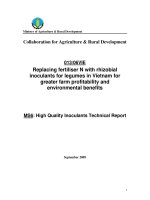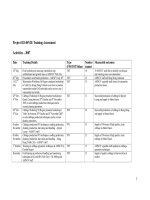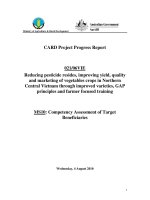Báo cáo khoa học nông nghiệp " Protecting productivity, incomes and trade through improved health surveillance of Vietnam’s plantations " ppt
Bạn đang xem bản rút gọn của tài liệu. Xem và tải ngay bản đầy đủ của tài liệu tại đây (1.36 MB, 9 trang )
1. Research Project Title
CARD Project 023/07VIE: “Protecting productivity, incomes and trade through
improved health surveillance of Vietnam’s plantations”.
2. Name of Reporter
Dao Ngoc Quang
Forest Plant Protection Research Division
Forest Science Institute of Vietnam.
3. Implementing agency
Vietnamese Organisation
Forest Plant Protection Research Division
Forest Science Institute of Vietnam
Vietnamese Project Team Leader
Assoc. Prof. Dr. Pham Quang Thu
Australian Organisation
Department of Agriculture, Fisheries and Forestry,
Office of the Chief Plant Protection Officer
Australian Project Team Leader
Dr. Ian Naumann
Date commenced
June 2008
Completion date
May 2010
4. Introduction
In recent years Vietnam’s forest coverage has undergone rapid expansion, with a
marked increase in plantings of exotic species of Eucalyptus, Acacia and Pinus. This
expansion provides excellent opportunities for new international export markets for timber
products. However it also represents new and increased risks from forestry pests and diseases,
which in outbreak circumstances can have catastrophic consequences on plantation
establishment and productivity. These risks come from pest and disease species already
established in Vietnam, and exotic species not yet present in the country.
This CARD project aims to improve the capacity of Vietnam’s Forest Health workers
to undertake surveillance for pests and diseases and to identify those detected. Good
surveillance and early detection are critical to improve management outcomes for pest and
disease outbreaks; identify and respond to exotic incursions; and produce pest lists to meet
international export requirements.
5. Project objectives
To establish a forest pest and disease database and reference collection.
To provide training on forest health surveillance, damage assessment, pest risk
analysis, collection, preservation, identification and curation and to increase awareness
and understanding of forest health surveillance among stakeholders.
To establish and equip a pilot network of observation centres based on FSIV regional
centres supplemented by provincial Departments of Crop Protection.
To create linkages between Forestry, Agriculture and Quarantine agencies within
Vietnam and with regional and international organisations.
6. Materials and Methods
Establish database at FSIV, based either on existing MS Access Database (previously
developed by QDPI&F) or the National Phytosanitary Database (held by Plant
Protection, MARD). Database selection criteria will include amenability to
modification to suit forest surveillance data and ease of import/export of data. Training
will be provided in the use of database to FSIV officers. Initially, the database will be
populated with existing records following validation of identifications of existing
specimens, and then the database will be augmented throughout life of project with
new surveillance records, principally from three regional centres.
Establish pest and disease reference collections at FSIV. This will include
procurement of modern storage cabinets and unit trays, and improvements to current
curatorial techniques. Training in Australia and Vietnam will enhance specimen
preparation skills.
Surveillance skills (survey design, collection and preservation of specimens, data
recording, field identifications, laboratory identifications) initially will be enhanced
through 2-weeks training in Australia and through a series of 3-day workshops in
Vietnam. The trainings will be led by Australian experts with assistance from alumni
of training in Australia and potentially experienced MARD scientists or Vietnamese
academics. Training materials will be assembled by QDPI&F in consultation with
senior FSIV scientists.
A trapping program will be established in Vietnam with simple traps provided by
the project. QDPI&F will monitor the program remotely by examination of trap
catches. Trap catches will provide additional records which will be entered by FSIV
scientists into their database.
A Field Guide will be prepared to the pests and diseases of plantation forests in
Vietnam. The Guide will be prepared by QDPIF in collaboration with FSIV, and will
include field and “automontage” laboratory images, and information on hosts,
impacts, distribution and management. The Guide will be suitable for scientists,
regional silviculture advisors and students, will be translated into Vietnamese by
FSIV, and will be printed in Vietnam. Selected extension materials (posters,
pamphlets) will be prepared by FSIV based on the text and images in the Guide; the
extension materials will be designed to enhance awareness of regional centres as
sources of information for growers.
The workshops in each regional centre, the trapping and on-going surveillance
program all will contribute to establishing the pilot network. Local visits will be used
to identify key individuals who will collect and process material, liaise with growers,
and communicate with FSIV, Hanoi.
7. Results and discussion
7.1. Implementation Highlights
7.1.1. Operational specimen-based forest pest and disease database
FSIV insect collection accessioned and entered into Excel spreadsheet and Forest
Health Surveillance Database.
Fig 1: FSIV insect collection accession records
Fig 2: Forest health Surveillance Database Schema
7.1.2. Identify key pests and diseases for each of the main plantation species grown in
Vietnam
The curated FSIV Hanoi pest collection comprises 800 accessioned specimens, of
which 400 have been identified to genus or species. The majority of specimens (700)
have associated host data.
Fig 3: FSIV insect collection in store boxes prior to curation
Fig 4: FSIV insect collection in cabinet drawers following curation
Fig 5: Specimens with new labels and FSIV Accession numbers
7.1.3. Surveillance training program for staff from regional research centres
The Forest Health Surveillance and Diagnostics Training Workshop was held in
Brisbane from 16-24 February 2009. The workshop focused on enhancing practical
skills among scientific and technical officers who are involved with Forest Health
Surveillance. The course provided training on symptom recognition and diagnosis;
surveillance methodology; damage assessment; pest risk analysis; and the collection,
preservation, identification and curation of arthropod and pathogen specimens. All
delegates were provided with training and reference material to help with this
including:
o Guidelines for surveillance for plant pests in Asia and the Pacific (Vietnamese
version, ACIAR/RIRDC 2005).
o Healthy hardwoods: a field guide to pests, diseases and nutritional disorders
in subtropical hardwoods (Carnegie, A., S Lawson, T Smith, G Pegg, C Stone
and J McDonald 2008).
o Pest and disease assessment in young eucalypt plantations: Field manual for
using the Crown Damage Index (Stone, C., M Matsuki and A Carnegie 2003).
o Manual of Diseases of Eucalypts in South-East Asia (Old, KM, MJ Wingfield
and ZQ Yuan 2003).
o Interactive key to insect orders
(
o Handbook of Insect Collecting: Collection, Preparation, Preservation and
Storage (Smithers, CN 1982).
Fig 6: FSIV researchers, Forest Health Surveillance workshop, Brisbane Australia
Fig 7: FSIV researchers setting insect panel traps, Brisbane Australia
A series of three Forest Health Surveillance Training Workshops were held at North
Eastern Vietnam Forest Scientific and Production Centre; North Central Vietnam
Forest Scientific and Production Centre; and Tropical Forest Research Centre from
21-29 September 2009. These training workshops targeted regional field staff who
would be directly involved in Forest Health surveillance. The two-day training
workshops had a strong practical emphasis, involving an initial half day workshop
session followed by practical sessions in the field. At the workshop each delegate was
presented with a printed and bound copy of the following:
o Introduction to workshop
o Survey methods
o FHS symptoms
o Trapping instructions
o Field form
o Sample collection protocols
o Protocols for Disease sample collection
o Protocols for Insect sample collection
o FHS Symptom recognition manual
o Forest Health Guide: symptoms of insect and fungal damage on trees
Fig 8: Forest Health Surveillance Training Workshop in Dai Lai, Vinh Phuc
Fig 9: Forest Health Surveillance Training Workshop in Pleiku, Gia Lai
7.1.4. Network of suitably equipped surveillance centres established at 3 regional centres
throughout Vietnam
The three FSIV regional centres to be established and equipped as surveillance centres
have been identified as:
o Tropical Forest Research Centre (Pleiku, Gia Lai).
o North Central Vietnam Forest Scientific and Production Centre (Dong Ha,
Quang Tri.
o North Eastern Vietnam Forest Scientific and Production Centre (Dai Lai,
Vinh Phuc).
A delegate from each of these nominated centres was present at the workshop and will
provide a focal point for further training and surveillance work within the region. In
addition to the general field equipment and collecting and setting materials provided to
each delegate these regional representatives have also received:
o GPS unit.
o Maggy lamp for specimen sorting.
o Insect storage boxes.
o Intercept panel traps.
7.1.5. Ongoing Forest Health Surveillance and Static Trapping Programs initiated in each
regional centre
Staff from the three regional centres were trained in various aspects of Forest Health
Surveillance and Static Trapping Programs. They will on-train staff in their regions
following their return to Vietnam.
Traps will be established in each region in Acacia, Eucalyptus and Pinus plantations in
three regional centres.
7.1.6. Forest Health Guide developed from existing data and data collected during training
Publication of a Field Guide, information sheets and posters of the key pests and
diseases in Eucalyptus, Acacia and Pinus plantations in Vietnam would be a very valuable
outcome for the project.
7.1.7. Extension material produced detailing symptoms and management options for key pests
and diseases
From the agent list, a number were selected for the development of Information Sheets
and Posters. These were selected on the basis of their importance to forestry in
Vietnam, as well as according to the availability of reliable information on the agents.
The information sheets and posters contain more detailed material than the Field
Guide, including information on distribution, impact, surveillance and management.
7.1.8. Joint training in surveillance and diagnostics for FSIV and PPD
The Vietnam training workshops included 19 delegates from FSIV, 30 from PPD, 05
from Forestry Department and 01 from Tay Nguyen Forestry.
7.2. Smallholder Benefits
The production of a Field Guide and Extension materials will benefit smallholders
through increased understanding and awareness of forestry pest and disease issues and
their potential impacts on tree health.
7.3. Capacity Building
The Forest Health Surveillance Training Workshops held in Vietnam in September
2009 were a major capacity building component of the project. During the course of
the workshops a number of people were identified as possible candidates to undertake
further post-graduate study in Australia and South Africa.
The Forest Health Field Guide and associated Extension materials are a major
resource to improving the understanding and awareness of individual pests and
diseases and their impacts on tree health.
7.4. Publicity
An article was submitted for publication in the CARD Newsletter (No. 6 Jan 2010),
describing aims of the project and giving details of the Brisbane and Vietnam training
workshops.
8. Conclusion and Suggestion
The existing forestry insect collection, housed at FSIV Hanoi, has been curated, and
databased and much of the material identified.
A number of workshops have been held in both Australia and Vietnam to provide
surveillance training to FSIV and Plant Protection Department Forest Health workers.
A Forest Health Surveillance and Diagnostics Training Workshop, held in
Brisbane in February 2009, was attended by eight delegates. These delegates had a
background in forest health research and were selected to lead surveillance activities
in their own regions and train local staff in surveillance techniques. The workshop
provided detailed training across a broad range of topics, including symptoms and
agents of timber and tree disorders, surveillance and collection methods, insect
identification and morphology, pathogen identification and life histories, tree
nutritional disorders, and development of surveillance plans.
Three Forest Health Surveillance workshops were held for Forestry workers in
Vietnam during September 2009. These workshops had a strong practical emphasis
with extensive field sessions covering field data recording, handling and rearing of
pest and disease specimens, insect trap methodology and use of GPS. The workshops
were well received, leaving delegates considerably more confident to undertake a
range of surveillance and diagnosis activities.
Forestry regional offices at Vinh Phuc, Quang Tri and Gia Lai will form a pilot
network of Forest Health observation centres, providing improved services and
advice to local tree growers. In addition to the training provided to local staff these
centres have been equipped with field collecting kits, laboratory equipment, GPS
units, digital cameras, insect trapping materials, and insect voucher specimens. This
will enable local staff to undertake surveillance, supported by the diagnostic capacity
at FSIV Hanoi. The pilot network of observation centres is a precursor to a
coordinated national surveillance system for Vietnam.
The fully illustrated Guide will include information on symptoms, hosts, distribution
and age of tree attacked for approximately 35 pest and disease species present in
Vietnam, as well as information on the main exotic agents of concern.
Supporting extension material will enhance awareness of pest and disease issues
amongst State Forest Enterprises and small farmers, and promote regional FSIV
centres as sources of information and advice.
The immediate benefits of this CARD project include skills gained by FSIV and PPD
staff. These benefits will extend to large and small landholders through improved
services and advice for pest and disease detection and management, and ultimately to
increased productivity in the expanding industrial plantations and reforested areas.
Improved knowledge of plantation health status will enhance Vietnam’s potential to
access international timber markets.









